In observation of the Veterans Day holiday, all County offices will be closed on Tuesday, Nov. 11, 2025. Offices will reopen for regular hours on Wednesday, Nov. 12. Many County services are available 24/7 on our Online Services webpage.
In observation of the Veterans Day holiday, all County offices will be closed on Tuesday, Nov. 11, 2025. Offices will reopen for regular hours on Wednesday, Nov. 12. Many County services are available 24/7 on our Online Services webpage.
Rainwater collection, also called rainwater “harvesting,” is the process of capturing, storing, and directing rainwater runoff and putting it to use. Water from roof gutter downspouts is usually directed onto landscaped areas and is incidentally consumed by plants, but this form of use is not regarded as rainwater harvesting.
Actual rainwater harvesting involves the collection of rainfall runoff from rooftops, concrete patios, driveways, and other impervious surfaces. Rainwater collection systems vary from simple and inexpensive to complex and costly. Typically, rooftop rainwater collection systems are simple, consisting of gutters, downspouts, and storage containers. Inexpensive rainwater storage systems commonly make use of an above-ground container such as a barrel or plastic tank with a lid to reduce evaporation and bar access for mosquitos to breed. Any container capable of collecting the rain shedding from a roof or patio can be used as a rainwater harvesting system, but to be in conformance with Colorado water law, the container additionally must be equipped with a sealable lid. More sophisticated systems have “first flush” diverters that are recommended to exclude capture of the initial rain that might carry impurities from the roof.
Colorado residents should understand that water rights in Colorado are unique compared to other parts of the country. The use of water in this state and other Western states is governed by what is known as the prior appropriation doctrine. This doctrine of water allocation controls who uses water, how much water may be used, the types of uses allowed, and when those waters can be used. A simplified way to explain this system is often called the priority system or “first in time, first in right.” It may seem strange that rainwater harvesting in Colorado is so carefully watched, but understanding why this is so can provide valuable insight into the way water is shared in Colorado. In our arid environment, every drop counts, and water rights holders depend upon the runoff from snowmelt and rainfall to supply the beneficial uses to which they apply their water rights. Captured precipitation consumed “out of priority” may deprive downstream and senior water rights holders of their right to use water from the natural stream, which comprises water that originates as snow and rain. Even though the detention of rooftop precipitation might only be temporary and minimal, it may still alter the nature of historic flow patterns. More information can be found on the Colorado Division of Water Resources per C.R.S. 37-96.5-102 and 103.
Most homeowners in Colorado are now allowed to use rain barrels to collect rainwater.
A maximum of two rain barrels with a combined storage of 110 gallons or less are allowed at each household.
Collected rainwater may be used to irrigate outdoor lawns, plants, or gardens. Untreated rainwater collected
from roofs is not safe to drink.
Catchment Area
The catchment area is the first point of contact for the rain—generally the roof. If you are planning to use your collected rainwater for landscape purposes, typical asphalt shingles are fine. Wood shingles may contain preservatives that may be harmful to human health and metal roofs tend to shed contaminants.
The size of the roof determines how much water you will be able to harvest Area of roof (feet squared) x rainfall depth (inches) x 0.63 = Harvested Water in gallons.
Example:
40 feet long by 20 feet wide = 800 square feet of roof / 800 x 0.5 x 0.63 = 252 gallons when it rains ½ inch / 800 x 0.1 x 0.63 = 50 gallons when it rains 1/10 inch = Over the course of year = 1000 gallons!
Storage
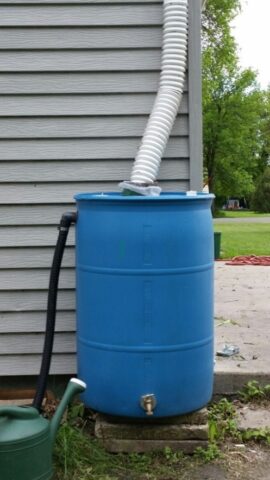
Always use good safety practices when installing or making your rain barrel, and when using power tools. You might be able to find cheap barrels from bottling companies, bakeries, delis, feed stores, and other bulk food service places. You could also use a large trash can with a sealable lid. Pre-manufactured barrels can be ordered online or purchased through hardware stores.
Vessel
HB 16-1005 requires storage vessels to have a sealable lid. You can cut a hole in the lid and attach a fine screen for a mosquito-proof inlet or cut many holes in the lid and attach a larger piece of screen.
Another option would be to have your inlet go in the side of the barrel, near the top. The barrel should have an overflow outlet, an inlet for the downspout, and one to two hose spigots (at 3-4 inches from the bottom of the barrel to avoid sediment).
Distribution
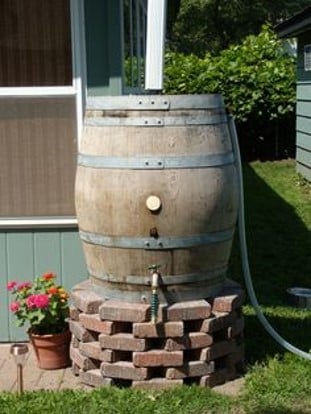
Choosing a site
The area where the barrel is sitting should be sturdy. A full barrel weighs around 400 pounds, so make sure it is secure! Concrete blocks can be used to make an area sturdier, which will also raise the barrel and increase the pressure. Consider the length of the hose you will be using, and how far your barrel is from your landscape.
Installation
Select a downspout. You may need to cut your downspout to accommodate your barrel. Some things you may need when installing and/or making your barrel:
Placement
Elevate the rain barrel. Water flow increases when the barrel is elevated. And, it’s MUCH easier to connect your hose. Install attachment for downspout for filtration.
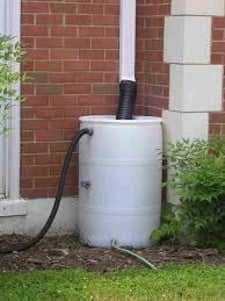
Using a rain barrel per Colorado HB 16-1005:
The answer is no. Section 3 of Colorado HB 16-005 prevents an HOA from prohibiting a unit owner from using rain barrels for precipitation collection. However, an HOA can regulate where you put it and/or how it looks or is screened.
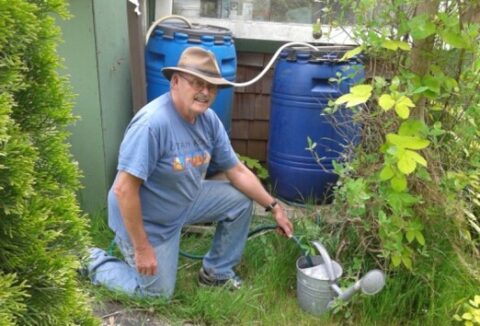
Please note: A person shall not use precipitation collected under this article for drinking water or indoor household purposes.
The benefit of a rain barrel is the ability to control the application of the harvested water — you can use it when you want to and where you want to.
It depends on several factors, including:
You can adequately water (with ~1”) approximately 180 square feet (slightly smaller than a 15 x 15-foot area).
Rain barrels are only ecologically relevant if you USE them.
It is ideal to use your collected rainwater within a week. Research has shown that it is acceptable to store rainwater for up to a month, however, if held longer, you should drain it.
During winter, you should disconnect your barrel, dry it, and store it upside down with the spigot open.
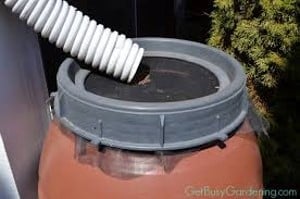
In urban areas, mosquitoes tend to breed anywhere that holds and stores water for at least a week, and mosquito larvae and pupae live in standing water.
You should cover the inlet from the downspout into the barrel with a fine screen to keep mosquitoes from entering and completely empty the barrel at least once per month to prevent any mosquitoes that may have found their way in from breeding.
Your overflow hose should be at least 8 feet, this will prevent mosquitoes searching for water from finding your barrel. You can also attach a piece of screen to the hose adapter.
You may also buy mosquito dunks. The dunks contain a naturally occurring soil bacteria (Bacillus thuringiensis israelensis (Bti)) that is ingested by larvae and kills them.
Relatively speaking, rainwater in Colorado is generally of good quality.
One of the biggest problems here is that rain is infrequent, which leaves a lot of time for bird droppings, dust, and other contaminants to build up on rooftops.
Heavy metals have also been detected in rainwater collected from rooftops.
Depending on how you intend to use your rainwater, this may or may not be a concern.
You may install a “first-flush” diverter.
Overflow of rainwater can potentially damage your home’s foundation if the barrel is up against the house, or the water isn’t going where you want it.